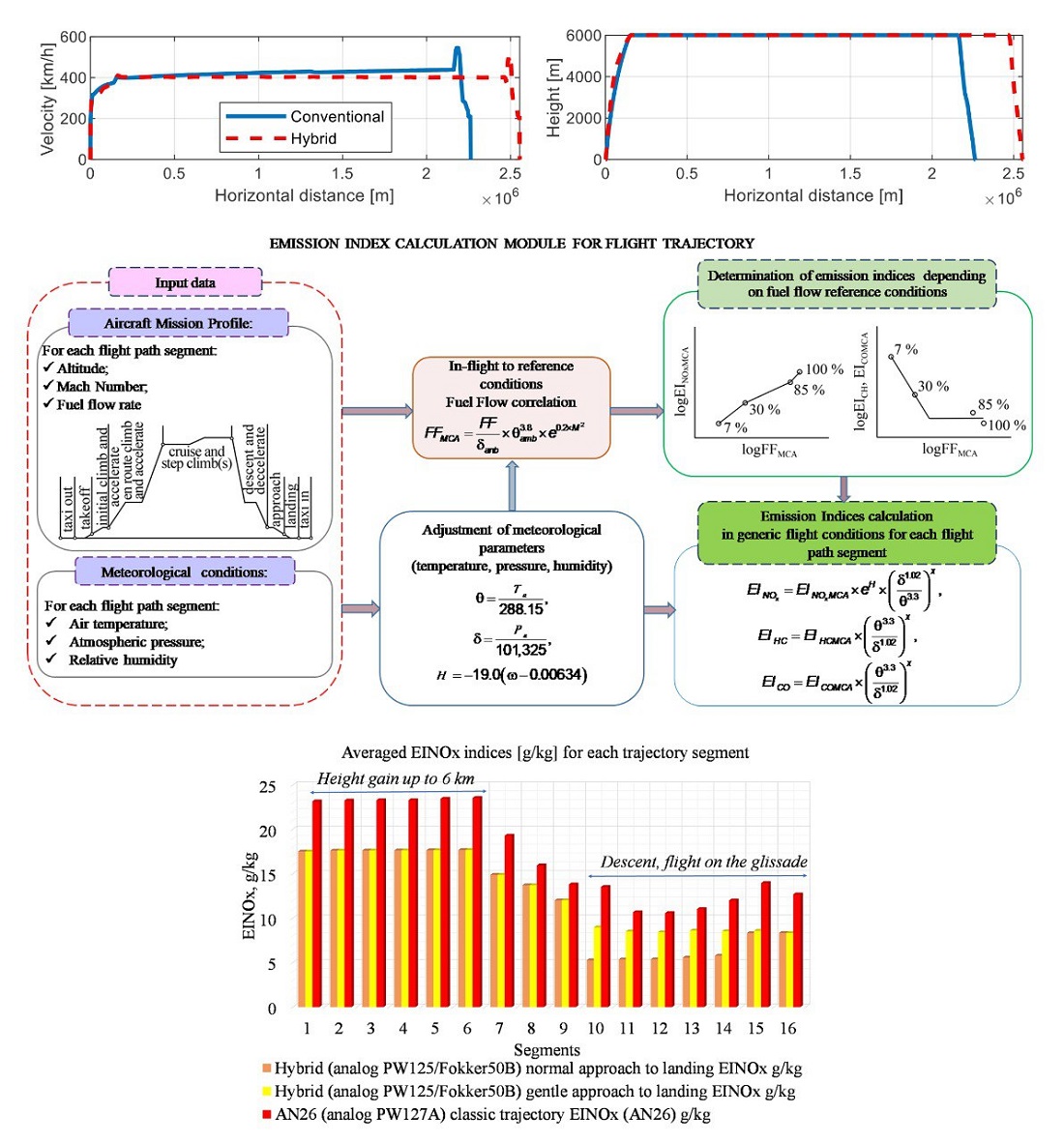Improving the calculation module for estimating pollutant emission from conventional and hybrid regional aircraft
DOI:
https://doi.org/10.15587/1729-4061.2024.302793Keywords:
pollutant emission, flight trajectory simulation, hybrid power plantAbstract
For the aviation sector, it is extremely important to devise revolutionary solutions in the field of technology to restrain the potential impact of civil aviation on the environment to the level of the established strategic goals of ACARE (FlightPath2050). The introduction of innovative technologies (improvement of the combustion chamber, the introduction of electric hybrid power plants on airplanes, and the use of alternative aviation fuel) will ensure the sustainable growth of air transportation.
To assess the effectiveness of advanced technologies, it is extremely important to have a model for calculating global/local emissions that takes into account the parameters of the flight path of conventional and hybrid aircraft, operational characteristics of the aircraft engine and hybrid powerplant, and the features of sustainable fuel.
The improved module for calculating emission indices by combining the module for calculating the parameters of the flight path and the results of calculating the thermogas-dynamic calculation of the aircraft engine makes it possible to detect the influence of fuel consumption (engine thrust) on the values of the emission indices. This feature is representative for evaluating the efficiency of hybrid powerplants because the electrification of the aircraft fleet is primarily aimed at reducing fuel consumption.
The analysis of simulation results reveals that the fuel consumption and EINOx are significantly reduced (for the climb stage – 25 %; for the descent stage – 30 %) for the hybrid AN26 compared to the conventional AN26. The specified operational measure, in the part of the low-pitch descend, significantly reduces EICO for the hybrid AN26 by an average of 50 % compared to the descend stage for the conventional trajectory.
The results of calculations for the entire flight path demonstrate that the use of a hybrid power plant for An26 contributes to an average reduction of fuel consumption by 10 %, NOx emissions by 25 %, water vapor emissions by 10 %, and CO2 by 10 %.
References
- Zaporozhets, O., Isaienko, V., Synylo, K. (2021). PARE preliminary analysis of ACARE FlightPath 2050 environmental impact goals. CEAS Aeronautical Journal, 12 (3), 653–667. https://doi.org/10.1007/s13272-021-00525-7
- Boeing Market Outlook (2018). Seattle.
- Global Networks, Global Citizens. Global Market Forecast 2018-2037. Airbus. Available at: https://www.airbus.com/sites/g/files/jlcbta136/files/2021-07/Presentation-Eric-Schulz-GMF-2018.pdf
- Effects of Novel Coronavirus (COVID-19) on Civil Aviation: Economic Impact Analysis. ICAO. Available at: https://www.icao.int/sustainability/Documents/COVID-19/ICAO_Coronavirus_Econ_Impact.pdf
- ICAO Environmental Report 2022. ICAO. Available at: https://www.icao.int/environmental-protection/Pages/envrep2022.aspx
- Flightpath 2050. Europe’s Vision for Aviation. Report of the High Level Group on Aviation Research. Available at: https://www.arcs.aero/sites/default/files/downloads/Bericht_Flightpath_2050.pdf
- Aviation Environmental Report 2022. Office of the European Union. https://doi.org/10.2822/04357
- Doc 9889. Airport Air Quality (2011). ICAO.
- Turbovintovoy dvigatel' TVZ-117VMA-SBM1. Rukovodstvo po tehnicheskoy ekspluatatsii. Kniga 3.
- GRABIT. Available at: https://www.mathworks.com/matlabcentral/fileexchange/7173-grabit
- Kim, B., Rachami, J. Aircraft Emissions Modeling under Low Power Conditions. Paper # 716. Available at: https://citeseerx.ist.psu.edu/document?repid=rep1&type=pdf&doi=4506739f2ff5d5d38b499f7ba39d37bf176e766f
- Aircraft and Airport-Related Hazardous Air Pollutants: Research Needs and Analysis (2008). Transportation Research Board. https://doi.org/10.17226/14168
- Madden, P., Park, K. (2003). Methodology for Predicting NOx Emissions at Altitude Conditions from Ground Level Engine Emissions and Performance Test Information. Technical Report DNS 90713.
- Duchêne, N., Synylo, K., Carlier-Haouzi, S. (2011). Deliverable D1 – Validation Test Report, CS-GA-2009-255674-TURBOGAS. TURBOGAS Deliverable.
- Tereshchenko, Yu. M., Kulyk, M. S., Mitrakhovych, M. M., Volianska, L. H. (2015). Teoriya teplovykh dvyhuniv. Hazodynamichnyi rozrakhunok elementiv hazoturbinnykh dvyhuniv. Kyiv: NAU, 292.
- de Vries, R., Brown, M., Vos, R. (2019). Preliminary Sizing Method for Hybrid-Electric Distributed-Propulsion Aircraft. Journal of Aircraft, 56 (6), 2172–2188. https://doi.org/10.2514/1.c035388
- Zaporozhets, O., Makarenko, V., Tokarev, V., Kazhan, K., Synylo, K. (2023). Modelling the noise characteristics of a regional turboprop hybrid-electric aircraft. International Symposium on Electric Aviation and Autonomous Systems. Warsaw. Available at: https://2023.iseasci.org

Downloads
Published
How to Cite
Issue
Section
License
Copyright (c) 2024 Kateryna Synylo, Vitalii Makarenko, Andrii Krupko, Vadim Tokarev

This work is licensed under a Creative Commons Attribution 4.0 International License.
The consolidation and conditions for the transfer of copyright (identification of authorship) is carried out in the License Agreement. In particular, the authors reserve the right to the authorship of their manuscript and transfer the first publication of this work to the journal under the terms of the Creative Commons CC BY license. At the same time, they have the right to conclude on their own additional agreements concerning the non-exclusive distribution of the work in the form in which it was published by this journal, but provided that the link to the first publication of the article in this journal is preserved.
A license agreement is a document in which the author warrants that he/she owns all copyright for the work (manuscript, article, etc.).
The authors, signing the License Agreement with TECHNOLOGY CENTER PC, have all rights to the further use of their work, provided that they link to our edition in which the work was published.
According to the terms of the License Agreement, the Publisher TECHNOLOGY CENTER PC does not take away your copyrights and receives permission from the authors to use and dissemination of the publication through the world's scientific resources (own electronic resources, scientometric databases, repositories, libraries, etc.).
In the absence of a signed License Agreement or in the absence of this agreement of identifiers allowing to identify the identity of the author, the editors have no right to work with the manuscript.
It is important to remember that there is another type of agreement between authors and publishers – when copyright is transferred from the authors to the publisher. In this case, the authors lose ownership of their work and may not use it in any way.









